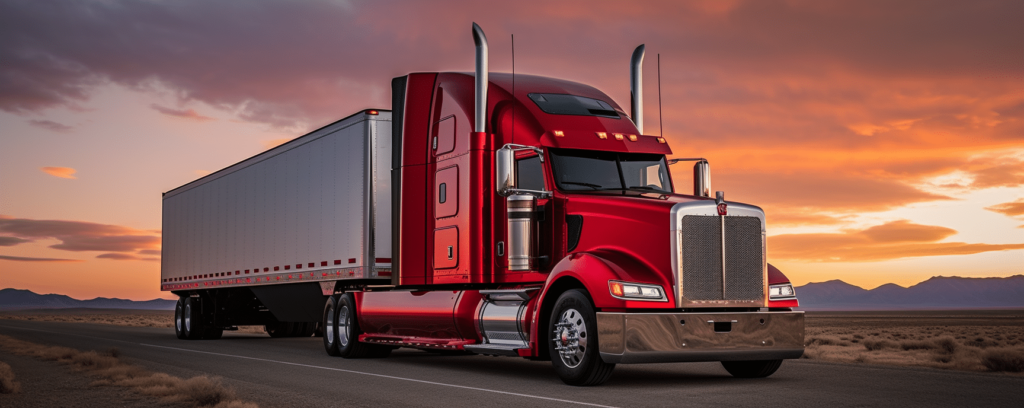
Understanding and properly utilizing a Jake Brake is crucial for managing a truck’s deceleration. Our guide covers the mechanics, advantages, and proper application of Jake Brakes, ensuring you optimize performance and legality on the road.
Key Takeaways
- Jake Brakes reduce reliance on service brakes, leading to potentially lower maintenance costs and improved control in deceleration scenarios, particularly for large diesel vehicles.
- The use of Jake Brakes on wet or slippery roads requires caution due to the impact on vehicle dynamics, such as increased risks of skidding due to the braking force being applied directly to the drive wheels.
- Compliance with local noise ordinances is critical when using Jake Brakes, as some areas have specific restrictions due to the potential for noise pollution.
Contact us today and we will help you get the compensation that you deserve.
Understanding the Jake Brake Mechanism
The Jake Brake, formally known as a compression release engine brake, is a mechanism installed in large diesel engines to slow down a moving vehicle. This mechanism, also referred to as a compression release brake, works by releasing compressed air from the engine cylinder at the peak of the piston’s stroke, thereby preventing the compressed air from returning its energy to the crankshaft for the down-stroke. This results in a decelerating effect on the vehicle, reducing the need for the service brakes and leading to reduced service brake maintenance.
Jake Brakes, named after Jacobs Vehicle Systems who first introduced them, offer an alternative method of deceleration without causing excessive wear on the traditional friction brakes. This brake system, also known as the Jacobs engine brake, is particularly beneficial for large diesel vehicles, where the service brakes alone may not suffice in situations needing quick deceleration or during prolonged downhill drives. Truck drivers can enhance vehicle control and curtail maintenance costs through a thorough understanding and appropriate use of the Jake Brake.
The Role of Compressed Air in Engine Braking
Compressed air plays a significant role in the operation of Jake Brakes. When the Jake Brake is activated, the exhaust valves in the cylinders of diesel engines open, releasing the trapped compressed air. This is achieved by using hydraulic pressure to open the exhaust valve at the end of the compression stroke, facilitated by the fuel injector rocker arm.
The expulsion of compressed air generates a braking force that slows down the vehicle by curbing the engine’s speed or RPMs. This resistance against driveline rotation further decelerates the vehicle, marking the essential role of the engine retarding brakes, also known as Jake Brake, in this process. Some areas may prohibit compression braking due to noise concerns.
How the Jake Brake Alters Engine Function
The Jake Brake, an engine brake alters the operation of the exhaust valves by modifying engine function. When the Jake Brake is activated, the compressed air in the engine cylinders is directed out and expelled through the exhaust valves. This process interrupts the rotation of the crankshaft, leading to the deceleration of the truck.
In this way, the Jake Brake turns the engine into a power-absorbing air compressor, playing a key role in slowing down the vehicle. However, being cognizant of local laws that may forbid the use of Jake Brakes due to noise pollution is crucial.
Decoding the Operation of Jake Brakes
For any truck driver, getting a grasp on the operation of Jake Brakes is of utmost importance. To engage the Jake Brake system, the driver must release the accelerator and flip the engine brake switch, usually located near the manual gear shift. This action will engage the system and slow down the vehicle. The Jake Brake switch typically has settings labeled as Low, Off, and High, each corresponding to the level of engine braking. The Low setting offers a mild deceleration force, the High setting provides a more pronounced slowing effect, and the Off setting deactivates the Jake Brake.
However, considering the impact of the Jake Brake on the vehicle’s dynamics is essential when it’s in use. The use of Jake Brakes affects the operation of the engine’s exhaust valves, which aids in deceleration and could affect the handling and stability of the vehicle, especially on slippery or wet road surfaces.
Engaging the Jake Brake: Switches and Settings
The process of engaging the Jake Brake starts by flipping a switch, usually located on the dashboard or behind the steering wheel, and releasing the accelerator. Different truck models might have different types of switches for activating the Jake Brake, such as a three-stage switch comprising an on/off switch, throttle switch, and clutch switch.
Upon activation of the Jake Brake switch, the exhaust valves in the engine cylinders are triggered to open following the compression cycle, leading to the release of the compressed air from the cylinders. This helps preserve the engine RPMs, thereby aiding in the regulation of the vehicle’s speed and ensuring the engine’s continued effectiveness in decelerating the truck.
The Impact of Jake Brakes on Vehicle Dynamics
The use of Jake Brakes has a significant impact on vehicle dynamics, including traction and stability. Therefore, drivers must proceed with caution when utilizing Jake Brakes on slippery roads. The braking force of the Jake Brake is applied solely to the vehicle’s drive wheels. This can increase the risk of skidding or jackknifing on slippery road surfaces.
Despite these considerations, the Jake Brake is an invaluable tool for truck drivers. Its use not only reduces wear on service brakes but also enables improved vehicle control. But, as with any tool, correctly understanding their usage for maximum benefit and safety is a must.
The Benefits of Using Jake Brakes

- Prolong the lifespan of service brake shoes
- Mitigate the risk of overheating or ignition
- Decrease brake wear
- Prevent brake fade
- Reduce wear on conventional braking systems
These benefits make Jake Brakes an essential tool for large vehicle operators.
Moreover, using Jake Brakes can lead to significant cost savings. For instance, owner-operator Grant E. Sheldon indicated potential savings of up to $1,000 per year in brake maintenance expenses. In addition to saving money, Jake Brakes contribute to overall vehicle safety by enabling trucks to decelerate more rapidly, reducing strain on the standard braking system, and assisting drivers in retaining control over their trucks.
Preserving Service Brake Shoes with Engine Braking
The utilization of Jake Brakes plays a significant role in preserving service brake shoes. This is achieved by:
- Reducing the wear and tear on the brake shoes
- Preventing overheating
- Extending their lifespan
- Decreasing the need for frequent maintenance.
Frequent use of service brakes, particularly when combined with aggressive driving, frequent braking, and sudden stops, can hasten brake pad wear and substantially diminish their lifespan. However, the use of Jake Brakes alleviates this issue by preserving lower temperatures, thereby averting the overheating of friction brakes and sustaining their functionality over extended periods.
Legal Considerations for Jake Brake Usage
While the Jake Brake is a powerful tool for truck drivers, awareness of its legal implications is crucial. The substantial noise generated by Jake Brakes has led to local laws prohibiting their use in specific areas. These laws are primarily driven by concerns about noise pollution, resulting in the restriction of Jake Brake usage in certain areas.
Regulations regarding Jake Brake usage vary considerably from state to state in the U.S. Some states have distinct statutes pertaining to brake retarder use, while others require prior written approval for local restrictions. Failure to comply with these laws can result in civil fines, underscoring the importance of understanding and adhering to local laws and regulations.
Strategies for Minimizing Jake Brake Noise
Given the noise concerns associated with Jake Brakes, there are strategies to minimize this noise. One such strategy is the use of specialized mufflers and turbochargers. These advancements in technology have led to the development of new types of mufflers and turbochargers that effectively silence the noise generated by compression braking.
Following local regulations and being aware of areas where the use of Jake Brakes is prohibited is also crucial. Many towns have noise ordinances in place that prohibit engine braking, and fines are enforced to deter the use of loud Jake Brakes. Therefore, respecting these laws and restrictions to uphold a quiet and peaceful environment is of the essence.
Innovations in Jake Brake Technology
The evolution of Jake Brake technology has been substantial over the years. Innovations have led to the development of:
- Quieter systems
- Improved efficiency in engine braking
- Advancements in noise reduction technology, such as sophisticated mufflers and turbochargers, that are specially engineered to alleviate the characteristic noise associated with Jake Brakes.
Further improvements like High Power Density engine brakes and Cylinder Deactivation Technology (CDA) have significantly increased Jake Brake efficiency. These advancements have enabled Jake Brakes to:
- Address 85% of a vehicle’s braking requirements
- Maintain higher average downhill speeds
- Decrease the time and distance needed for slowing down heavily loaded vehicles.
Best Practices for Safe Jake Brake Operation
Safely operating the Jake Brake is as important as understanding its mechanism. This involves tasks such as checking engine oil levels, warming up the engine, and choosing the right gear and speed. Before activating the Jake Brake, drivers should ensure the engine reaches a minimum oil pressure of 20 psi. Additionally, letting the engine warm up is significant as it can stave off brake overheating and boost the brake’s performance.
Choosing the appropriate gear and speed is also critical when utilizing a Jake Brake. The Jake Brake should generally be utilized within the shifting range of approximately 1,100 to 1,400 RPMs. Adhering to this range enables effective engine braking without inducing excessive strain. Selecting the appropriate speed during the use of a Jake Brake is also crucial to avoid overheating of the brakes and to effectively regulate the vehicle’s speed by utilizing the engine brake.
Checking Engine Oil and Warm-Up Procedures
Before using a Jake Brake, drivers should verify that their oil levels are not low and warm up the engine. Using a Jake Brake with low engine oil can result in engine damage. Thus, it is crucial to allow the engine to warm up and verify that the oil level is at an optimal level.
The importance of warming up the engine before using a Jake Brake is paramount. The brake’s effectiveness is enhanced when the engine is at operating temperature. Furthermore, warming up the engine helps in preventing brake overheating, which can impact the brake’s performance. The engine should reach its operating temperature before the Jake Brake is utilized.
Selecting the Appropriate Gear and Speed
Selecting the right gear is key to effectively operating a Jake Brake. The recommended RPM range for operating a Jake Brake is approximately 1,100-1,400 RPMs. It is particularly recommended for 6th gear or below, especially when carrying a heavy load. Engaging a lower gear enhances the Jake Brake’s efficacy by optimizing engine compression braking, thereby diminishing the reliance on service brakes that may overheat during extended descents.
Drivers should also be cautious about the truck’s weight pushing the RPMs over the engine’s maximum RPM limit when descending. This can diminish engine braking effectiveness and escalate wear on the service brake shoes. Therefore, maintaining the right speed when using a Jake Brake to avoid these potential issues is essential.
Frequently Asked Questions
Why is Jake Brake illegal?
Jake Brakes are illegal due to the loud noise they produce when the compressed air is expelled through the exhaust, leading many cities and towns to enact laws prohibiting their use, especially in residential areas near interstates. This ban is due to the noise emission, as stated by the National Highway Traffic Safety Administration (NHTSA).
Why do truckers call it a Jake Brake?
Truckers call it a Jake Brake because it was created by Jacobs Vehicle System inc., and the brake is technically known as a compression release engine brake. It has several different names, including Jacobs Brake and Jake Nett Brake.
What is Jake Brake slang for?
Jake Brake is a slang term for an engine brake, which is a generic trademark for engine brakes and refers to compression brakes in general, especially on large vehicles and heavy equipment.
What is a Jake Brake and how does it work?
A Jake Brake is a compression release engine brake used in large diesel engines. When activated, it releases compressed air from the engine cylinder to create a decelerating effect on the vehicle.
How do Jake Brakes preserve service brake shoes?
Jake Brakes help preserve service brake shoes by reducing wear and tear and preventing overheating, which can extend their lifespan and reduce the need for frequent maintenance.
Last updated Thursday, April 11th, 2024 | Written by Anthony B. Golden






